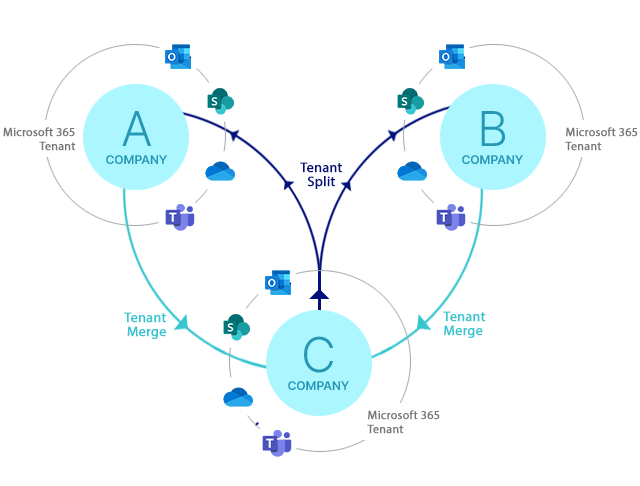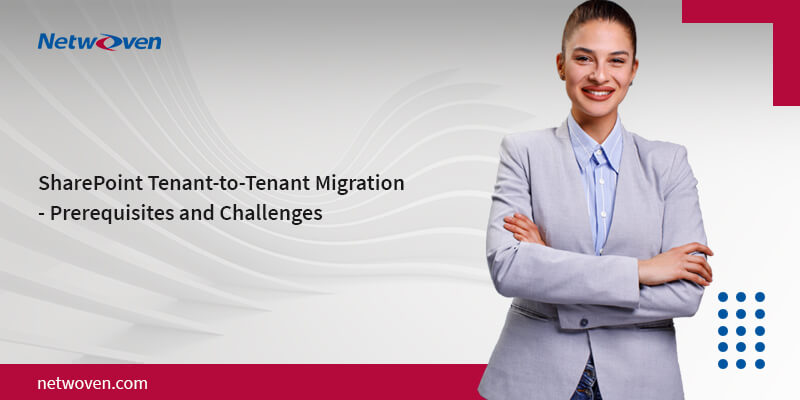Introduction:
SharePoint has become the primary collaboration platform for organizations the world over. Over a period, businesses find themselves in circumstances where they must migrate from one tenant to another. The scenarios can range from Mergers & Acquisitions (M&A), or a name change as a part of re-branding activities. In most cases, other than migrating simple data from one environment to another, several gigabytes of sites, documents, libraries, and lists along with their permissions, collections, designs, etc. must be migrated. Due care must be taken to ensure that the integrity of the environment is preserved while all this is being implemented.
Prerequisites for SharePoint tenant-to-tenant Migration
SharePoint tenant-to-tenant migration projects can be quite complex and time-consuming. Making sure your business satisfies the criteria can ensure faster implementation.
Here is a to-do list before you go ahead with the migration-
- Make sure you have an active Microsoft 365 subscription with SharePoint Online
- Entrust someone from the organization with the SharePoint Online admin access
- Familiarize yourself with the existing tenant’s site(s) structure & permissions
- Learn the size of document libraries that need to be migrated
- Appoint a reliable service provider with migration expertise and communicate with them before initiating the migration on any customizations, web part functionalities, 3rd party integrations, library views, and other requirements relevant to your organization.
- Identify a contact person in your organization who must collaborate with all stakeholders in order to drive the project to completion.
- Configure and provide access to the organization’s resources such as servers, systems, networking equipment, etc. whenever they are needed.
- Assess the impact the migration will have on employees, most importantly the high-risk users, to ensure minimal disruptions.
Challenges of SharePoint tenant-to-tenant migration
SharePoint cross-tenant migration can be as complicated as other migrations, even though it is being executed between two environments that are on the same platform. Few reasons why SharePoint tenant migration is complex –
- All the content cannot be backed-up on one tenant (like it is done for an on-premises solution) and restored on the new tenant, as it is a cloud-native product.
- The probability of data loss is quite high even after moving all the contents to an Azure-hosted file share and migrating the data to the new tenant. Also, the configurations and customizations on the old tenant must be rebuilt.
- Microsoft’s infrastructure too decides the factors such as latency and performance, as much as local determinants.
- In large-scale migrations, it may not be possible for individual users to move their contents by themselves. An admin will have to do it on behalf of the entire organization.

What Does SharePoint Tenant-to-Tenant Migration Involve?
Specialized tools are required to perform SharePoint tenant-to-tenant migrations. Irrespective of the usage of Microsoft’s SharePoint Migration Tool or any other third-party tool, the migration approach will be more or less similar because all the tools need SharePoint API. Also, most of the tools use Azure for data migration in larger volumes.
SharePoint tenant-to-tenant migration step by step
Readying the source environment
- To begin with, the content must be evaluated, analyzed, and triaged, as a part of preparing the source environment for migration. This opportunity can be used to identify the size and types of data that need to be migrated from the source environment.
- The versions of the files that have to be made available on the new SharePoint Online tenant must be determined.
- Size of the packages can be estimated at this stage based on the number of files to be transferred and their sizes. Also, the smaller the size of the file, the larger the overhead. This information will help in optimizing the size of the project.

Ebook : 10 most important issues and how to solve them when migrating to SharePoint Online today!
Whether you are a business leader, IT professional, or end-user, the Netwoven SharePoint migration eBook can educate you on the benefits and opportunities of migrating to SharePoint on the cloud. Download it today!
Get the eBookPreparing the destination environment
To prepare the destination environment, the first step is to create an account with SharePoint Online administrator or Site Collection administrator rights. In case the new tenant must be built from the ground up, the admin must create site libraries and schemas. Before initiating the migration, they also must replicate the structure of the document library together with any customizations.
Commencing the migration
The migration is started by creating endpoints, irrespective of the tool that is being used. Authentication must be provided to the tool for both the source and destination environments.
Executing the migration
The contents are migrated from the source SharePoint Online tenant to the destination, at this stage. The steps here may vary based on the tool that is being used and the number of users. In the case of just a few users, the recommended method is to move all the contents in a single pass. If the number of users is high, some of the supported items can be first moved before a specific date, and later, the remaining content can be transferred in delta passes.
Steps after migration
Post-migration, reports are generated by the migration tool, with details of the items that have been migrated, errors, and other relevant information. It is important to validate that all the data has been moved. Once the validation is completed, the authentication app (if used), can be disconnected. The subscription for the older SharePoint tenant would no longer be required.
We would love to be a trusted IT services partner in your organization’s Digital transformation journey. Please reach out to us so that we can leverage our tenant-to-tenant migration services to help you.






















